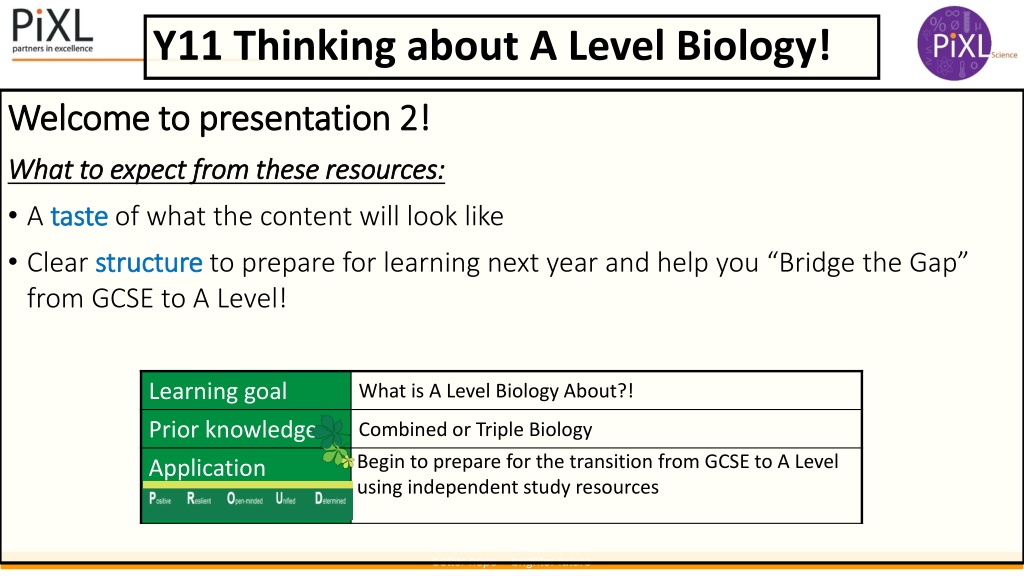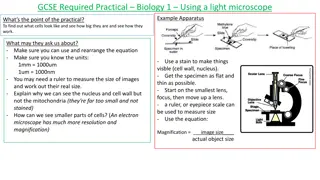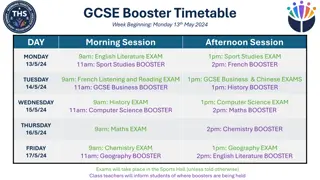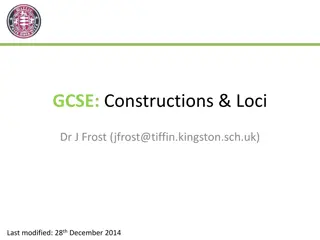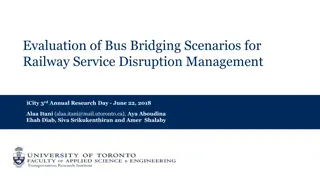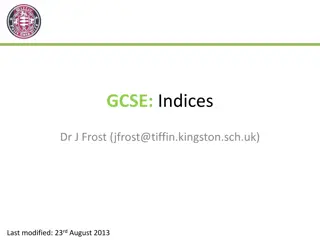Bridging GCSE to A Level Biology: Essential Skills and Knowledge
Prepare for the transition to A Level Biology with this helpful resource covering essential maths skills, standard form, statistical tests, and more. Gain insights on what to expect and how to bridge the gap from GCSE to A Level effectively for a brighter future in biology. Explore the clear structures and independent study resources provided to support your learning journey.
Download Presentation

Please find below an Image/Link to download the presentation.
The content on the website is provided AS IS for your information and personal use only. It may not be sold, licensed, or shared on other websites without obtaining consent from the author. Download presentation by click this link. If you encounter any issues during the download, it is possible that the publisher has removed the file from their server.
E N D
Presentation Transcript
Y11 Thinking about A Level Biology! Welcome to presentation 2! Welcome to presentation 2! What to expect from these resources: What to expect from these resources: A taste taste of what the content will look like Clear structure structure to prepare for learning next year and help you Bridge the Gap from GCSE to A Level! Learning goal What is A Level Biology About?! Prior knowledge Application Combined or Triple Biology Begin to prepare for the transition from GCSE to A Level using independent study resources better hope brighter future
Y11 Thinking about A Level Biology! Welcome to presentation 2! Welcome to presentation 2! What to expect from these resources: What to expect from these resources: This will give you a really clear idea of some of the maths skills you will need Biology is deceptive Biology is deceptive There is a lot of maths in the examinations, you need to be confident applying your skills better hope brighter future
Presentation 3: Essential Knowledge for A Level Biology better hope brighter future
Essential Maths for Biology At least 10% of the marks for assessments in Biology will require the use of mathematical skills. These will be applied in the context of Biology and will be at least the standard of higher tier GCSE Mathematics. You need to be able to demonstrate a range of mathematical skills across the A Level course. Here we will explore some of the mathematical skills that you will need to use that you might be less familiar with from your GCSE studies. better hope brighter future
Essential Standard Form Standard form is used when numbers are very small, or very large. For example: the nucleus of an atom is 1 x 10-15m and Earth is 1.49 x 1011m from the Sun. These numbers would be too great to write out in full all the time, so standard form helps to communicate this effectively. Here are some more examples of standard form being used: Decimal Standard Form 2.86x10-7 0.000000286 1.65x1010 16 500 000 000 5.948x10-5 0.00005978 8.962x104 89620 2.9x10-1 0.29 Task: Construct a list of rules for converting numbers to standard form better hope brighter future
Essential Statistical Tests Statistical tests are used in Biology to determine whether or not results have been due to chance, or have been caused by another factor. There are three tests that you may be required to use or apply: 1. Chi squared: used with categoric data to see if differences in frequencies are the same as what would be expected, e.g. in a blood sample, is the ratio of red to white blood cells healthy? 2. Students t-test or t-test: used to determine whether continuous data has a normal distribution and whether there is any difference between two sets of data, e.g. have boys performed better in their exams than girls? 3. Correlation coefficient or Spearman Rank: used to test whether there is a relationship between two variables, e.g. is a persons weight related to their height? better hope brighter future
Essential Statistical Tests Statistical tests are used in Biology to determine whether or not results have been due to chance, or have been caused by another factor. There are three tests that you may be required to use or apply: 1. Chi squared: used with categoric data to see if differences in frequencies are the same as what would be expected, e.g. in a blood sample, is the ratio of red to white blood cells healthy? 2. Students t-test or t-test: used to determine whether continuous data has a normal distribution and whether there is any difference between two sets of data, e.g. have boys performed better in their exams than girls? 3. Correlation coefficient or Spearman Rank: used to test whether there is a relationship between two variables, e.g. is a persons weight related to their height? An easy way to remember these two is if you are drawing graphs! Hint: An easy way to remember Chi is if you are comparing actual (observed) results to expected results. Hint: An easy way to remember t-test is if you are comparing the means for two groups of data. Hint: better hope brighter future
Essential Statistical Tests TASK Which statistical test would you use for the following experiments/data sets? 1. The number of yellow and white daffodils that come from bulbs where I would expect a ratio of 1:1. 2. Do people who drink energy drinks have a higher blood sugar? 3. Is there a difference in the number of girls in Y9 and Y10? 4. The yield of crop from two different fertilisers. 5. The number of males and females born in a litter of pups. better hope brighter future
Essential Statistical Tests TASK Which statistical test would you use for the following experiments/data sets? 1. The number of yellow and white daffodils that come from bulbs where I would expect a ratio of 1:1. 2. Do people who drink energy drinks have a higher blood sugar? 3. Is there a difference in the number of girls in Y9 and Y10? 4. The yield of crop from two different fertilisers. Chi squared Spearmans/Correlation T test T test 5. The number of males and females born in a litter of pups. Chi squared better hope brighter future
Essential Statistical Tests You will need to know some common features of each of these tests: Hypothesis: the relationship you expect to find or are investigating, e.g. there is a significant difference in the number of lung cancers developed by non-smokers compared to smokers. Null hypothesis: the opposite of the hypothesis, e.g. there is no significant difference in the number of lung cancers developed by non-smokers compared to smokers. Degrees of freedom: the number of categories (classes) being tested. Critical value: the value at which you accept or reject the hypothesis. better hope brighter future
Essential Probability Probability tells us how likely something is or the chances of something occurring. Probability is used in Biology to judge whether data has been caused by chance, and to make predictions about expected outcomes. You will use probability in relation to statistical tests as well as in predicting the genetic makeup of populations. Probabilities can be expressed as a percentage, decimal or fraction e.g. 50%, 0.5 or . better hope brighter future
Essential Standard Deviation Standard deviation measures the spread of data. In Biology this can be used to determine whether there is a significant difference between groups, e.g. between species of animals, or the efficacy of different drugs on patient symptoms. You will not be required to calculate standard deviation in your exams, but you can be asked to interpret graphs and tables that use it. The example on the right shows the price of 3 different fruit. The bars show the mean price. The bars show +/- one standard deviation from the mean. This tells us that there is a significant difference in the price of plums compared to apples and oranges, but that there is no significant difference between the apples and oranges. better hope brighter future
Essential Finding the Gradient of a Line To find the gradient m of a line always show your working and always draw a triangle. The hypotenuse of the triangle must be at least as big as half of the line of best fit. If the line of best fit is a curve, draw a tangent to the curve at the point where the gradient is required. The gradient m can be calculated by: m = change in y / change in x = y / x The unit for the gradient is the unit for the y- values divided by the unit for the x-values. better hope brighter future
